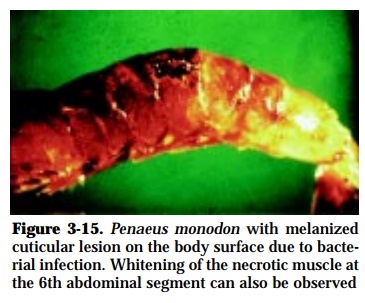Chapter: Health Management in Aquaculture: Bacterial diseases
Non-luminous Vibrios Bacterial Disease - Internal or Systemic Infections of Crustaceans
Non-luminous Vibrios
CAUSATIVE AGENT:
Vibrio parahaemolyticus, V. alginolyticus, V. anguillarum, V. vulni-ficus, V. damsela, V. fluvialis and V. penaeicida.
SPECIES AFFECTED:
Penaeus monodon, P. vannamei, P. japonicus
GROSS SIGNS:
Affected shrimp may show erratic or disoriented swimming alternating with periods of lethargy. There is loss of appetite. General signs of severe stress include opaqueness of abdominal muscle (Fig. 3-15), an-orexia and expansion of chromatophores.

In larval and early postlarval shrimp, signs include melanization, ne-crosis of appendage tips and the presence of large numbers of swarm-ing bacteria visible in the hemocoel of moribund or weak shrimp. Due to loss of appetite, fecal strands cannot be observed and gut is empty. Hepatopancreas of affected shrimp showed varying degrees of inflam-mation, hemocytic infiltration and fibriosis (Fig. 3-16).

EFFECTS ON HOST:
Mortality in some instances is nearly 100% of affected population. Majority of cases of vibriosis is secondary in nature, occurring as a result of other primary conditions, including other infectious diseases, nutritional diseases, extreme stress, wounds, etc.
DIAGNOSIS:
Infection may be detected by bacteriological (isolation, purification and identification), histological (demonstration of rod-shaped bacteria in tissues of diseased shrimp), and serological (slide agglutination, FAT and ELISA using specific antibodies) methods; and by Polymerase Chain Reaction (PCR).
PREVENTION AND CONTROL:
• Maintain good water quality and use nutritionally adequate diets.
• Minimize handling and overcrowding; reduce effects of other forms of stress.
• Apply commercially available probiotics; use low salinity rearing water and reservoirs; practice crop rotation and install greenwater culture system and other system modifications.
• Perform immunoprophylaxis or vaccination.
• The disease can be treated with rigorous water management.
• Apply antibiotics and antibacterial substances only as a last resort.
Related Topics